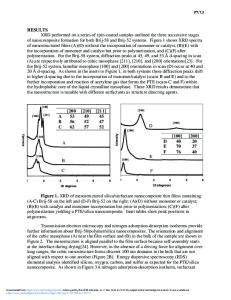Design of a Passive-Matrix Smart Window by the Conjugated Polymer Electrochromics
- PDF / 144,625 Bytes
- 6 Pages / 612 x 792 pts (letter) Page_size
- 93 Downloads / 271 Views
0937-M07-12
Design of a Passive-Matrix Smart Window by the Conjugated Polymer Electrochromics Rei Furukawa1, Chunye Xu2, and Minoru Taya1,2 1 Materials Science and Engineering, University of Washington, Seattle, WA, 98195-2120 2 Mechanical Engineering, University of Washington, Seattle, WA, 98195-2600
ABSTRACT Preliminary development towards passive matrix Electrochromic (EC) device in conjugated EC polymer system is discussed. High contrast ratio of dark and bleached pixels is obtained by modification of counter and working electrode capacitance ratio and spacer geometry. Mask patterning and laminar electropolymerization for multicolor EC system application is discussed as well. INTRODUCTION Electrochromic (EC) polymers are derivatives of conjugated polymers that enable the electric current flow through the conjugated chain, which exhibits different colors in certain electric potentials. Transparent switchable EC materials have been mainly focused on monotone-transparent digital switching devices such as smart windows and EC sunglasses [1-4]. On the other hand, recent displaying technologies such as liquid crystal, OLED, CRT are all light emitting types. The application of transparent switchable ECs to a display will enable the new appearance, transparent state, in addition to the desirable displaying patterns. It would hold additional benefits such as conservation of backlight energy and usage as a localized window. The conventional displaying technologies have been classified to either of two types of pixel driving method, passive-matrix and active-matrix. For transparent switchable EC display, passive-matrix is more favorable in order to maintain the high transparency and simple device mechanism. The difficulty of EC passive-matrix system is to achieve the uniform coloration ratio of dark and bleached pixels. Undesired voltage applied to the non-crossing pixels in the objective row and column cannot be removed due to the passive matrix principle. Such side effect phenomena will create an intermediate darkness in whole row and column of the objective pixel [5]. In this paper we show the potential of EC polymer system in order to minimize this undesired effect by simple device modification.
EXPERIMENTAL DETAILS Passive-matrix EC device Indium Tin Oxide (ITO) coated glass substrate, obtained from Delta Technologies (Stillwater, Minnesota) was glued onto Silicon Wafer purchased from Montco Silicon Techonolies (Spring, Pennsylvania) using the CrystalbondTM509. Photoresist AZ1512 was spincoated in 500 rpm for 5 seconds, and 3000 rpm for 30 seconds, continuously. After 5 minutes bake under 90 °C, the wafer was exposed to ultraviolet beam for 3 seconds using positive photolithography mask, which is designed for four by four passive matrix pixels of 3.7 mm square each. After UV exposure, the wafer was developed by developer AZ315 for 60 seconds and postbaked for 35 minutes under 110 °C. ITO coated glass substrate was removed from the wafer and etched under acidic solution (H2O (de-ionized): HCl: HNO3=1:1:0.08). Later
Data Loading...











